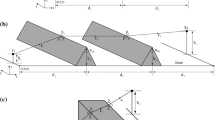Abstract
Spatial transfer function for wide band wireless communication system is analyzed by using FDTD and DFT method. Ray-based method is not sufficiently accurate, when the size of objects on the propagating path is comparable to the wavelength. In our proposed method, the tranfser function can be obtained exactly by using the FDTD method. For the numerical examples, the transfer functions in an aperture of the waveguide are calculated by proposed procedure. Furthermore, experimental verification is made by using two-dimensional propagation system, which is constructed of copper plates, antennas and vector network analyzer. The proposed algorithm is valid for estimating of the spatial transfer function.
Similar content being viewed by others
REFERENCES
Y. Karasawa and H. Iwai, “Formulation of Spatial Correlation Statistics in Nakagami-Rice Fading Environments,” IEEE Trans., Vol.AP-48,No.1, pp.12-18, 2000.
D. S. Polydorou, P. G. Babalis and C. N. Capsalis, “Statistical Characterization of Fading in LOS Wireless Channels with a Finite Number of Dominant Paths. Application in Millimeter Frequencies,” Int. J. of Infrared and Millimeter Waves, Vol.20,No.3, 1999.
J. B. Keller, “Geometrical theory of diffraction,” J. Opt. Soc. Am., Vol.52, pp.116, 1962.
S. Y. Seidal and T. S. Rappaport, “Site specific propagation prediction for wireless in-building personal communication system design,” IEEE Trans., Vol.VT-43,No.4, pp.879-891, 1994.
K. S. Yee, “Numerical solution of initial boundary value problems involving Maxwell's equations in isotropic media,” IEEE Trans., Vol.AP-14,No.4, pp.302-307, 1966.
C. M. Furse and O. P. Gandhi, “Why the DFT is Faster Than the FFT for FDTD Time-to-Frequency Domain Conversions,” IEEE Microwave and Guided Wave Letters, Vol.5,No.10, pp.326-328, 1995.
G. Mur, “Absorbing boundary conditions for the finite-difference approximation of the time-domain electromagnetic-field equation,” IEEE Trans. Vol.EMC-23,No.4, pp.377-382, 1981.
Author information
Authors and Affiliations
Rights and permissions
About this article
Cite this article
Motojima, K., Kozaki, S. Analysis of Spatial Transfer Function by Using FDTD for Wireless Communication. International Journal of Infrared and Millimeter Waves 22, 923–939 (2001). https://doi.org/10.1023/A:1014974616610
Issue Date:
DOI: https://doi.org/10.1023/A:1014974616610




